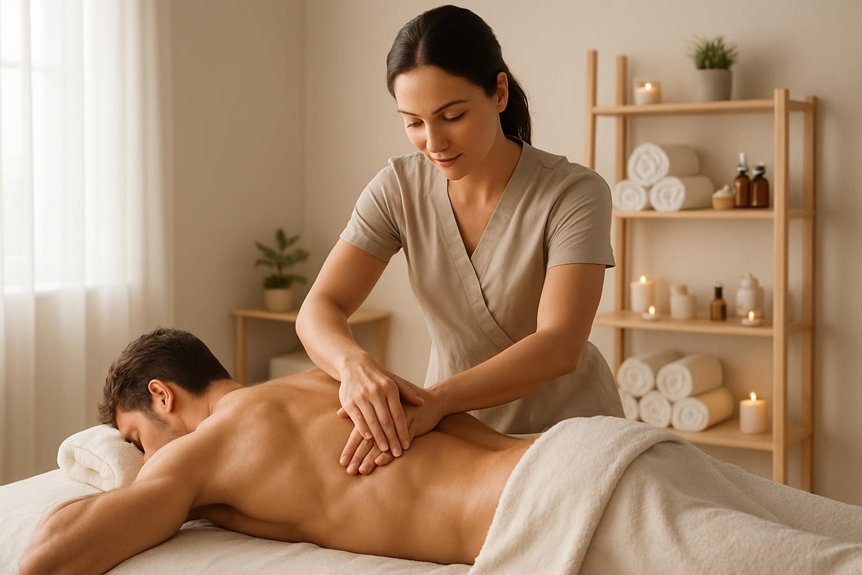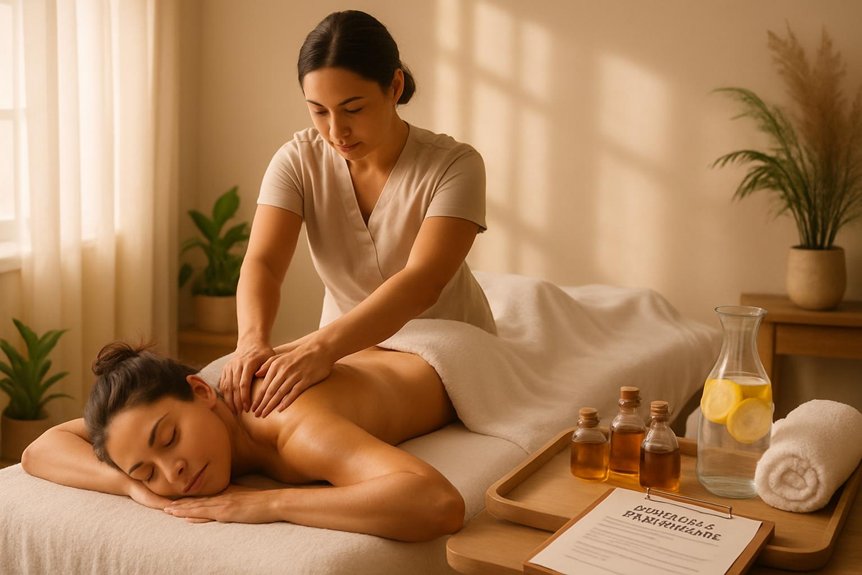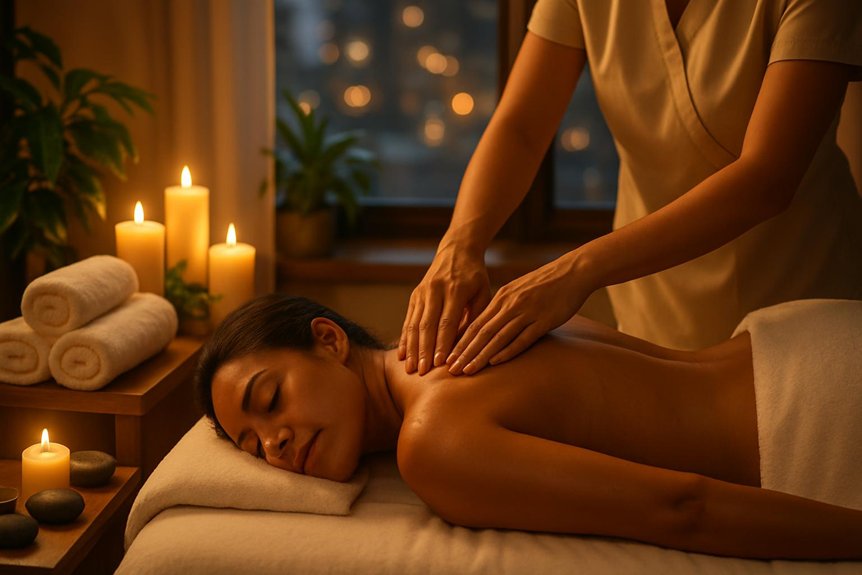This is available at reputable clinics such as Spa & Massage locations in London, where professionally trained therapists use evidence-based manual techniques to address chronic muscle tension and myofascial restrictions. Potential clients should select a facility near their home or workplace to enhance post-treatment recovery and convenience. Clinical settings with advanced practitioner expertise optimize musculoskeletal outcomes and overall wellness. Further information can guide individuals in selecting the ideal therapist and preparing effectively for their session.
Understanding This Massage and Its Benefits

How does this massage differ from other manual therapies in its impact on musculoskeletal health? It targets the deeper layers of muscle and connective tissue through sustained pressure and slow, deliberate strokes. Unlike superficial relaxation techniques, this approach focuses on the release of chronic muscle tension, adhesions, and myofascial restrictions.
Clinical evidence suggests that deep tissue massage may reduce inflammation, improve range of motion, and alleviate persistent musculoskeletal discomfort. At Spa & Massage, skilled therapists carefully assess and tailor each session to the client’s specific muscular patterns and therapeutic needs.
This precise intervention supports both physical restoration and a sense of connectedness, fostering long-term wellbeing. Many clients report increased mobility, diminished pain, and enhanced relaxation—benefits that extend beyond the immediate session. Deep muscle therapy is renowned for its effectiveness at addressing myofascial restrictions, which can help promote not only relief from pain but also improved overall musculoskeletal function.
What to Expect During a Session
A typical massage session at Spa & Massage begins with a thorough assessment of the client’s health history, presenting symptoms, and specific therapeutic goals.
The therapist customises each protocol, utilising evidence-based techniques targeting deep myofascial layers and chronic tension points.
During the session, slow, deliberate strokes and focused pressure are applied, often integrating forearm and elbow techniques to address adhesions and muscular restrictions.
Communication is encouraged to ensure pressure remains within the client’s comfort threshold while effectively facilitating tissue release.
Clinical-grade massage oils are used to support smooth, therapeutic movement and skin integrity.
Clients may experience both immediate relief and transient post-treatment soreness, for which aftercare recommendations—including hydration and gentle stretching—are provided.
The environment remains tranquil and confidential, fostering a sense of trust and connection.
How to Choose the Right Location for Your Massage
Following an expertly tailored massage session, selecting an appropriate clinic location substantially influences both therapeutic outcomes and overall client experience. Proximity is clinically relevant, as minimising travel post-treatment supports ideal muscular recovery and sustained relaxation.
Clients benefit from environments designed for tranquility, privacy, and sensory comfort, ensuring a seamless transition from therapeutic intervention to holistic well-being.
Accessibility factors—such as public transport links, flexible operating hours, and discrete entry—contribute to convenience and a sense of security.
At Spa & Massage, strategically positioned London clinics in Crouch End, Bayswater, Chiswick, Earl’s Court, Belsize Park, and Richmond provide well-rounded accessibility alongside expertly curated therapeutic environments.
Thoughtful consideration of location, atmosphere, and logistical ease empowers clients to prioritise self-care and nurture a deeply restorative, intimate experience.
Services at Our London Clinics
At Spa & Massage’s London clinics, deep muscle therapy services are performed by therapists with advanced training in musculoskeletal assessment and manual therapy techniques.
Each session is adapted to the client’s specific presentation, with bespoke pressure and targeted focus based on clinical findings.
This individualized approach is designed to optimize therapeutic outcomes and support long-term musculoskeletal health.
Experienced Deep Tissue Therapists
With rigorous training and a commitment to evidence-based practice, the massage therapists at Spa & Massage demonstrate advanced proficiency in musculoskeletal assessment and targeted manual therapy.
Each practitioner is adept at identifying myofascial restrictions and chronic muscular tension, employing systematic palpation and precise anatomical knowledge to address specific pain generators.
Continuous professional development guarantees familiarity with the latest clinical research and therapeutic modalities.
Clients benefit from therapists who cultivate a supportive environment, fostering trust and open communication.
This professional intimacy, combined with technical competence, enables therapists to deliver interventions that are both effective and attuned to individual comfort thresholds.
Spa & Massage prioritises safety, informed consent, and client dignity throughout the process, ensuring every deep tissue session is both therapeutic and deeply restorative.
Tailored Treatment Approaches
A thorough assessment forms the foundation of tailored massage interventions at Spa & Massage’s London clinics. Each client receives an individualised consultation, during which musculoskeletal imbalances, pain patterns, and lifestyle factors are clinically evaluated. This assessment enables therapists to identify specific areas of tension and adapt evidence-based techniques—such as myofascial release and trigger point therapy—to the client’s needs.
Treatment plans are meticulously crafted, integrating a combination of slow, targeted strokes and sustained pressure to address deep-seated adhesions. Therapists maintain ongoing communication throughout each session, ensuring the client’s comfort and facilitating therapeutic rapport.
The environment is designed to foster trust and relaxation, supporting a holistic experience. This personalised approach optimises both physiological outcomes and the client’s sense of connection and well-being.
Tips for Preparing for Your Appointment
Ideal preparation for a massage session includes clearly communicating personal health goals and areas of discomfort to the therapist, as practiced at Spa & Massage clinics.
Evidence supports adequate hydration prior to the session to facilitate tissue pliability and metabolic waste removal.
Arriving in loose, comfortable clothing is recommended to guarantee a seamless and relaxing experience.
Communicating Your Needs Clearly
Effective communication of individual needs and expectations is essential for achieving therapeutic outcomes in therapeutic deep massage. Prior to the session, clients are encouraged to articulate specific areas of discomfort, preferred pressure levels, and any previous experiences with massage therapy.
At Spa & Massage, therapists facilitate a confidential, open dialogue to assess musculoskeletal concerns, tailor techniques, and guarantee client comfort throughout the session.
Evidence supports that clear communication enhances relaxation, optimises tension release, and mitigates the risk of adverse effects.
Clients may express preferences regarding massage oil or sensitive regions, allowing therapists to adjust their approach accordingly. This collaborative exchange fosters a sense of trust and intimacy, enabling a bespoke treatment designed to address both physiological needs and individual wellbeing objectives.
Hydration Before Your Session
Why is pre-session hydration emphasised by massage professionals? Adequate hydration supports ideal cellular function, tissue elasticity, and circulatory efficiency—critical factors in the effectiveness of therapeutic deep massage.
At Spa & Massage, therapists advise clients to consume water prior to their appointment, as well-hydrated muscle fibres respond more receptively to manual manipulation, reducing discomfort and facilitating toxin mobilisation.
Evidence suggests that hydration enhances the body’s lymphatic response, which is pivotal when addressing deep-seated muscular tension.
Engaging in this preparatory step allows for more profound yet gentle therapeutic pressure, aligning with the clinic’s philosophy of personalised, attentive care.
Clients who arrive well-hydrated often report a heightened sense of intimacy with their own body, experiencing a deeper connection and more lasting benefits from each treatment.
Arriving in Comfortable Attire
In addition to adequate hydration prior to a deep tissue massage, appropriate clothing selection plays a significant role in ensuring treatment efficacy and client comfort.
At Spa & Massage, therapists recommend arriving in loose-fitting, non-restrictive attire, as this promotes ease of movement before and after the session. Restrictive garments can impede circulation and limit the body’s ability to relax, potentially diminishing the therapeutic benefits.
Upon arrival, clients are provided with privacy to change into suitable draping or massage attire, consistent with professional standards and personal modesty. This thoughtful preparation enhances the overall sense of safety and relaxation, allowing the therapist to apply targeted deep tissue techniques unimpeded.
Ultimately, mindful clothing choices support an intimate, seamless progression into the restorative environment Spa & Massage cultivates.
Aftercare and Ongoing Wellness Recommendations

Following a deep tissue massage, the body undergoes physiological changes that benefit from specific aftercare protocols to optimise recovery and therapeutic outcomes. Spa & Massage therapists recommend adequate hydration to facilitate metabolic waste removal and reduce post-treatment soreness.
Gentle stretching and light movement can enhance tissue pliability and prolong the benefits of the session. It is advisable to avoid strenuous activity for 24 hours, allowing musculoskeletal structures to recover. Applying a warm compress may alleviate residual tension.
Clients are encouraged to monitor their response and communicate any persistent discomfort. At Spa & Massage, ongoing wellness is supported through tailored maintenance plans, integrating regular massage, ergonomic guidance, and stress management advice.
This holistic approach fosters sustained muscular health and deepens the therapeutic intimacy of ongoing care.
Conclusion
As Odysseus sought calm after the storm, so too do clients find respite from musculoskeletal tension through evidence-based deep tissue massage. Choosing a reputable clinic—such as Spa & Massage’s London locations—ensures interventions are grounded in anatomical expertise and therapeutic precision. By integrating clinical guidance, individualized care, and ongoing aftercare, the pathway to relief becomes as navigable as a well-charted course, guiding individuals toward sustained musculoskeletal health and enhanced overall well-being.



